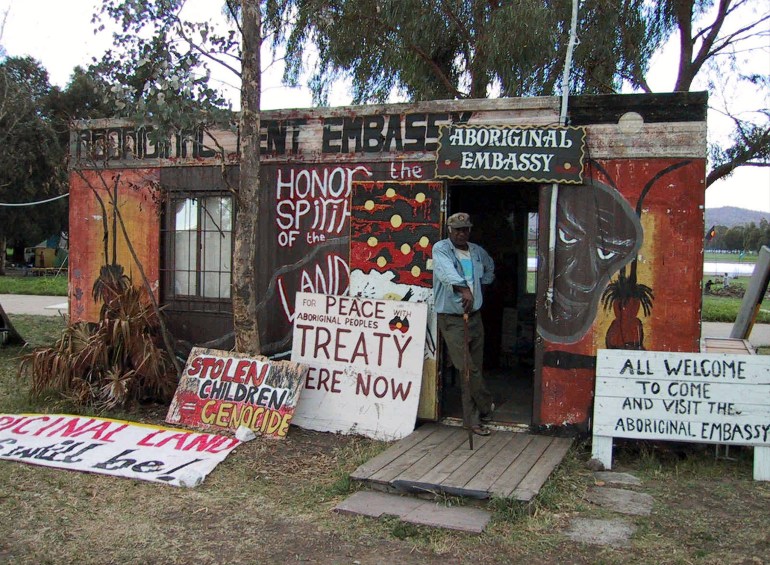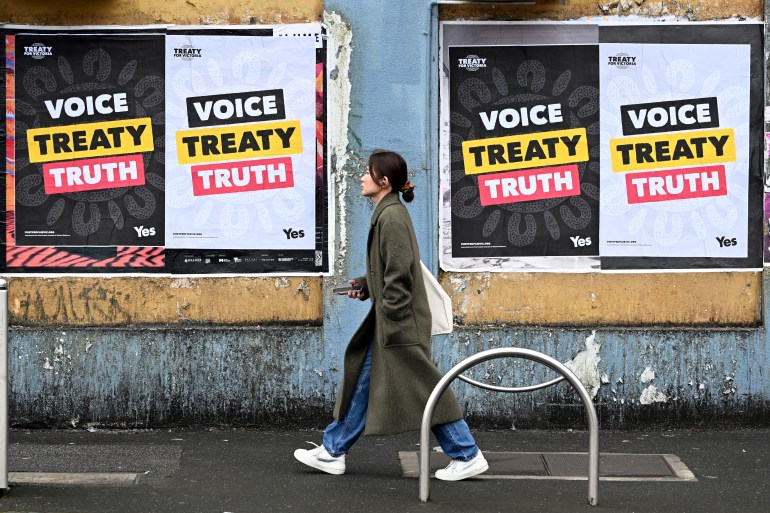The Australian referendum on an Indigenous Voice to Parliament is a part of a protracted historical past of Aboriginal individuals combating for his or her voice to be heard.
The referendum was known as after Aboriginal and Torres Strait Islander leaders issued the Uluru Assertion from the Coronary heart, a petition calling for a First Nations Voice to be enshrined within the Australian structure.
The Uluru assertion is the most recent of many petitions and protests from Aboriginal individuals calling for 3 separate processes referred to as Voice, Treaty and Reality, in various orders.
Australia has made restricted progress on implementing any of the processes, and in contrast to neighbouring New Zealand and different comparable nations, doesn’t have any treaties with Indigenous individuals.
However, the authors of the Uluru assertion say 60,000 years of ancestral ties between Indigenous individuals and the land are a “sacred hyperlink” that ought to not disappear from world historical past in “merely” 200 years.
As Australia heads to the polls on Saturday, October 14, right here’s a take a look at a few of the important moments in that lengthy historical past:
50,000 years in the past: Murujuga rock artwork
The estimated a million petroglyphs at Murujuga in Western Australia are amongst many examples of Indigenous rock artwork recording Indigenous historical past across the nation.
Since earlier than the final Ice Age, Murujuga artists have been portray animals, lots of which are actually extinct, reminiscent of nail-tailed wallabies and thylacines, also referred to as Tasmanian tigers. However conventional homeowners concern the work could possibly be the latest Indigenous heritage site to be broken or destroyed, attributable to a gas project within the space.
30,000 years in the past: the Story of Budj Bim
The Gunditjmara individuals’s story of their ancestral creation-being who revealed himself throughout a volcanic eruption that final occurred 30,000 years in the past has made some individuals say the story of Budj Bim could possibly be the oldest dwelling story on Earth.
A 6,600-year-old aquaculture system of weirs, channels and fish traps at Budj Bim obtained World Heritage itemizing from UNESCO in 2019.
January 26, 1788: ‘Invasion Day’
January 26 is the date that Captain James Cook dinner and Britain’s First Fleet arrived in Botany Bay in present-day Sydney in 1788.
The date is now a public vacation referred to as Australia Day however is marked annually by hundreds who take to the streets in Invasion Day protests.
1937: Petition for citizenship, land rights and illustration
In 1937, William Cooper, the Secretary of the Australian Aboriginal Development League, delivered a petition signed by greater than 1,800 individuals to the then-King of England, George VI. The petition known as for illustration in parliament, citizenship and land rights for Aboriginal individuals. Australia’s six British colonies grew to become a federation on 1 January 1901, however the British monarch, now King Charles III, stays Australia’s head of state by means of their consultant, the governor-general.
January 26, 1938: Day of Mourning
On January 26 1938, the Australian Aborigines League (AAL) and the Aborigines Progressive Affiliation (APA) organised a day of mourning at Australia Corridor in Sydney.
They held banners and launched an announcement saying: “[We] hereby make protest in opposition to the callous remedy of our individuals by the white males throughout the previous 150 years.”
The assertion additionally known as for “full citizen standing and equality inside the neighborhood” for Aboriginal individuals. Aboriginal individuals have been capable of vote in Australian federal elections since 1962, however they nonetheless face inequality in lots of areas, together with well being, and usually tend to be jailed than different Australians.
1963: Yirrkala bark petitions
The Yolngu individuals from Yirrkala in japanese Arnhem Land within the Northern Territory despatched bark petitions to the Australian parliament in Canberra in 1963. The paper petitions have been framed with bark work mapping the land of the Yolngu peoples, which have been being prospected for mining with out their session.
1965: Freedom Rides
In 1965, Charlie Perkins, one among solely two Aboriginal college students on the College of Sydney on the time, led a bunch of Aboriginal and non-Aboriginal college students on a bus journey by means of regional cities the place they protested about segregation, together with on the Moree swimming pool.
1972: Aboriginal Tent Embassy established
In 1972, the Aboriginal Tent Embassy was established on the lawns in entrance of Parliament Home in Australia’s nationwide capital Canberra. The tent embassy has continued ever since, though it has developed to incorporate delivery containers and different constructions.

Nineteen Eighties: Protests develop
Throughout the Nineteen Eighties, Aboriginal individuals and their supporters held a sequence of peaceable protests, together with in 1982 when Australia hosted the Commonwealth Video games, a sporting occasion for present and former colonies of the British empire.
Protests additionally happened across the nation in 1988, as the federal government and plenty of Australians held celebrations to mark 200 years since Captain Cook dinner’s arrival in Botany Bay.
1990-2005: The Aboriginal and Torres Strait Islander Fee (ATSIC)
Established by a Labor authorities in 1995, the Aboriginal and Torres Strait Islander Fee (ATSIC) was an Australian authorities physique during which Aboriginal Australians and Torres Strait Islanders might formally be included in authorities processes affecting their lives. ATSIC was later abolished in 2005, by the then-conservative authorities led by Prime Minister John Howard. The proposal to enshrine the Voice to Parliament within the Australian structure would imply that it could be harder for future governments to abolish the physique with no need to carry one other referendum.
1991: Yothu Yindi’s track Treaty
Sung in each English and Gumatj language, the protest track Treaty was launched by the band Yothu Yindi in June 1991 and rapidly climbed in the direction of the highest of Australian and worldwide music charts.
The track got here after the then-Labor authorities did not stay as much as guarantees it had made to contemplate introducing a Treaty course of.
1992: Eddie Mabo overturns ‘terra nullius’
In 1992, the Excessive Court docket of Australia overturned the declare made by Britain on the time of colonisation that Australia was “terra nullius”, land belonging to nobody, within the historic Mabo vs Queensland case.
Eddie Mabo, who introduced the case as he fought for recognition of his ancestral lands within the Torres Strait Islands, handed away a number of months earlier than the choice was introduced.
Native Title legal guidelines in Australia now give some restricted recognition of Indigenous individuals’s connection to their land, however aren’t comparable with treaty agreements.
2008: Australia says ‘Sorry’
On February 13, 2008, Prime Minister Kevin Rudd stood up in parliament to make a proper apology to Aboriginal and Torres Strait Islander peoples, and, specifically, the Stolen Generations – tens of hundreds of people that had been forcibly faraway from their households as youngsters underneath an official assimilation programme that continued from the mid-1800s into the Nineteen Seventies.
For the primary time, the Federal Parliament opened for the yr with a Welcome to Nation ceremony performed by native Aboriginal individuals.
2017: The Uluru Assertion from the Coronary heart
In 2017, Aboriginal and Torres Strait Islander leaders chosen as delegates to the First Nations Nationwide Constitutional Conference gathered at Uluru in central Australia the place they wrote and launched a petition referred to as the Uluru Assertion from the Coronary heart. The Uluru assertion was later thought of to be the driving power behind the 2023 Australian referendum on a Voice to Parliament, though the assertion additionally known as for a truth-telling physique to later be established as nicely.

2021: The Yoorrook Justice Fee created
In Could 2021, the state of Victoria created the Yoorrook Justice Fee, the primary official truth-telling physique in Australian historical past. Named Yoorrook after the Wemba Wemba phrase for fact, the fee has since heard and recorded testimonies from Aboriginal individuals detailing their experiences of dispossession and resistance.
The states of Victoria and Queensland are additionally individually pursuing their very own processes to create treaties with Aboriginal and Torres Strait Islander individuals.
2020: Lidia Thorpe turns into a senator
In 2020, Lidia Thorpe entered the senate carrying a possum pores and skin cloak along with her fist held excessive. She is one among six parliamentarians who’re Indigenous or have Indigenous heritage at the moment in federal parliament. Notably, Thorpe has taken a unique stance from nearly all of Aboriginal individuals who assist the Voice, arguing that Treaty and Reality processes ought to have come first.
If it wasn’t official earlier than, it most definitely is now. I’m so proud to be the primary Aboriginal Victorian Senator and dealing alongside my Greens colleagues. Thanks a lot to your nicely needs. pic.twitter.com/CdNqcnbjfZ
— Senator Lidia Thorpe (@SenatorThorpe) October 6, 2020
2023: Voice Referendum
The 2023 Australian referendum on an Indigenous Voice to Parliament is predicted to contemplate the proposal for a First Nations Voice to be included within the Australian structure. The referendum marketing campaign has been soured by disinformation and racism and polls counsel the proposal is unlikely to realize the bulk assist wanted.
